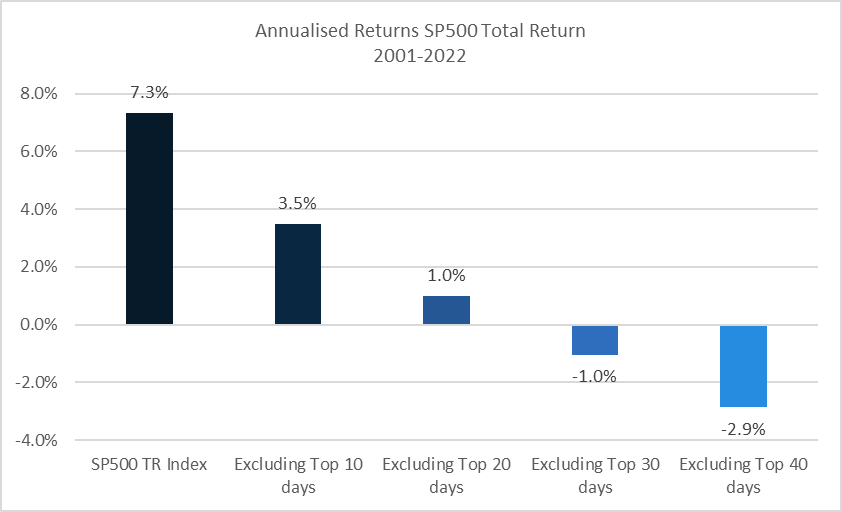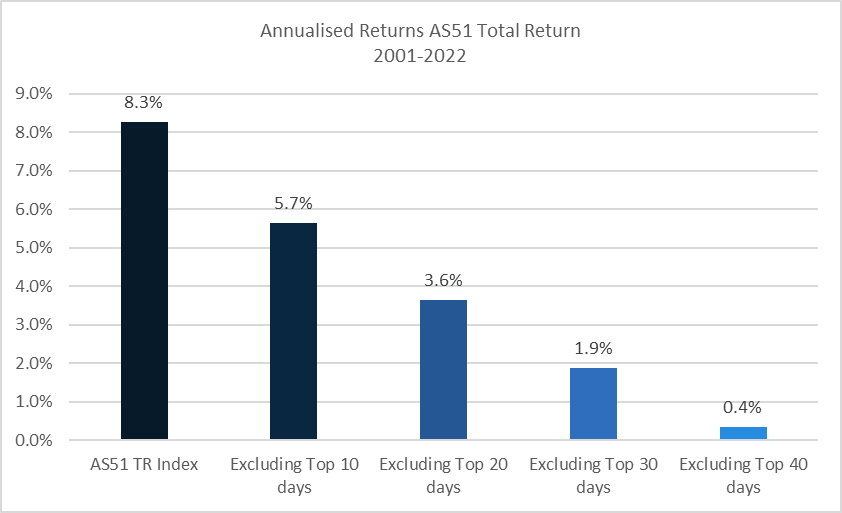It’s the age-old adage, “it’s not about timing the market, but about time in the market”, and it’s been proven to be true many times over the years with research pointing to how a well-diversified portfolio will generally outperform those trying to profit off specific turning points in the market.
With global equity markets experiencing a torrid time of late, down heavily since the turn of the year, plenty of investors are looking to try time the market by picking the bottom of the drop, or even selling too quickly in fear that the market will drop further. If there’s one thing history has taught us, it’s that in times like these it is important we keep our cool.
Timing the market is simply when an investor speculates on the best time to interact with the market based on their predictions for the future of the market.
Typically, this notion of “timing the market” is more apparent on the buying side where investors believe they can outsmart the market buying at a low and selling much higher, or where they feel the market is overvalued and needs to “cool” before they should buy.
In volatile beat up markets it’s important to keep a clear head and block out all the noise that can be attributed to groups that believe they can time the market. These groups can often be seen instructing investors to “wait for the bottom!” or to “be sure the rebound is real!”, misguiding investors and often resulting in them missing out on some of the best returns in these periods.
Some of history’s greatest investors have warned that trying to time the market by waiting can be costly, as market rebounds are usually at their strongest early on amid the rock bottom sentiment. Hence, the “be sure the rebound is real!” rhetoric can prove quite costly to portfolio performance.
Whilst the day trader is the epitome of timing the market, it doesn’t mean timing the market is exclusive to them, as often longer-term investors will increase their cash levels too if they are waiting for a dip. Meaning even the longer-term buy & hold investor can succumb to a level of market timing.
The Proof is in the pudding
With global equity markets spending significant amounts of time at all-time highs, many investors trying to time the market will be constantly waiting for a dip. In many of these periods where we are sitting at all-time highs they don’t coincide with a major dip, meaning these same investors are missing out on further gains as the market continues to climb and make new all-time highs.
It’s all well and good to be saying this, but just how much truth is there to the risks of being out of the market? Well, if we look at what would happen to investors’ performance if they missed key days in the market the results are quite staggering.
Looking all the way back to 2001, the below chart shows how missing the top 10, 20, 30 or 40 days for the past 21 years would impact returns relative to the S&P500 Total Return index (SPXT). If you invested in the SPXT in 2001 you’d have an annualised return of 7.3%, not too bad right? Well, if you missed 10 of the best days over the past 21 years because you were trying to time the market, your annualised returns would be less than half of that at 3.5%. The below chart shows this and takes it a few steps further across the 21-year period.
Chart 1: Annualised Returns for the S&P500 Total Return Index with varying levels of market timing

Source: Mason Stevens, Bloomberg, as at 23/05/2022
As you can see from the chart, missing the biggest days over history has a vastly detrimental impact on an investors’ portfolio. Whilst you’d be very unlucky to miss out on all these days you can see how big an impact missing out on strong days in the market is – something that is very possible when you’re waiting for the market to “bottom out” as markets tend to bounce strongly off their lows once found.
The below table shows how chart 1 returns would impact a $500k investment relative to the SPXT.

Source: Mason Stevens
Even when looking closer to home at the ASX 200 we can see that the trend is still very much present with returns varying from 8.3% annualised down to 0.4% across the same time period and parameters.
Chart 2: Annualised Returns for the ASX200 Total Return Index with varying levels of market timing

Source: Mason Stevens, Bloomberg, as at 23/05/2022
Final comments
As Jacqui mentioned in her note on Tuesday, we need to reset our mental models and, in this sense, rather than trying to time the market, thinking the market is either due a correction or it hasn’t quite hit the bottom yet, statistics show that we should simply invest and hold for the long term.
The master investor himself, Warren Buffet, has condemned trying to time the market in the past saying, “Since the basic game is so favourable, Charlie (Munger) and I believe it’s a terrible mistake to try to dance in and out of it based upon the turn of tarot cards, the predictions of “experts,” or the ebb and flow of business activity. The risks of being out of the game are huge compared to the risks of being in it.”
So, unless you have the coveted all-seeing crystal ball to help you time the market to perfection, we feel it’s best to invest when you’re ready to, rather than waiting to try time the market perfectly and missing out on returns along the way.
The views expressed in this article are the views of the stated author as at the date published and are subject to change based on markets and other conditions. Past performance is not a reliable indicator of future performance. Mason Stevens is only providing general advice in providing this information. You should consider this information, along with all your other investments and strategies when assessing the appropriateness of the information to your individual circumstances. Mason Stevens and its associates and their respective directors and other staff each declare that they may hold interests in securities and/or earn fees or other benefits from transactions arising as a result of information contained in this article.



